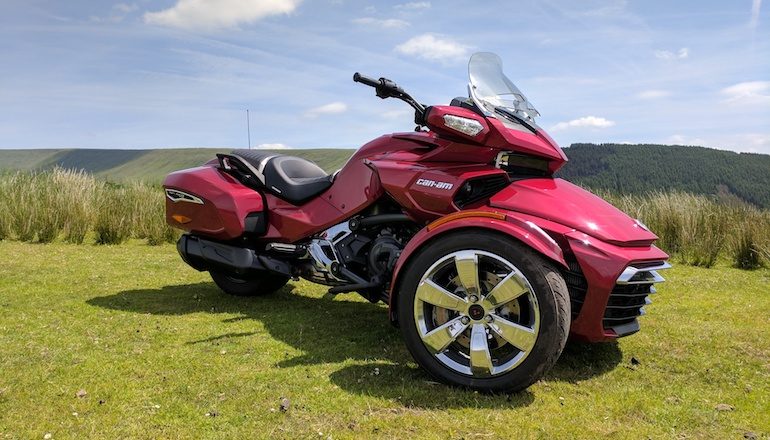
Canada-made vehicle puts the ‘whee’ in ‘three-wheeler’
The first thing Can-Am’s PR people will tell you about the three-wheeled Spyder is that it’s different than riding a motorcycle. They stress this several times: it’s different. Not like a motorcycle; not like a car; different.
READ MORE: Ask RideApart: Why isn’t the Can-Am Spyder More Popular? | RideApart
Being a cynical person, I’ll admit that I interpreted this as an attempt to lower expectations. Each time I was told that riding a Spyder was different, the word got translated in my head and became “not as good as” – eg, Riding a Spyder is not as good as riding a motorcycle.
Turns out I was wrong.
Zipping down the road astride a Spyder F3-T is indeed different than riding a motorcycle. But having sex is also different to riding a motorcycle; both experiences are lots of fun, and I try to partake in them as often as possible, but they are definitely different. So, being different is not a bad thing.
Admittedly, riding a Spyder is a little more like riding a motorcycle than having sex. Well, I guess I don’t know what you get up to in your bedroom, but unless it’s a special occasion my wife and I usually don’t introduce handlebars to our happy adult fun time. Equally, we don’t involve a 1330cc inline triple, producing roughly 115 hp and 96 lb-ft of torque at peak.
The Spyder F3-T, which Can-Am slots into its “cruiser touring” lineup, has those things – as well as 78 liters of storage space, comfy seating for rider and passenger, considerably less old-man looks than Spyders of old, and all kinds of spiffy creature comforts you might expect, like a stereo with USB input and a click-through menu with more pages than a Russian novel.
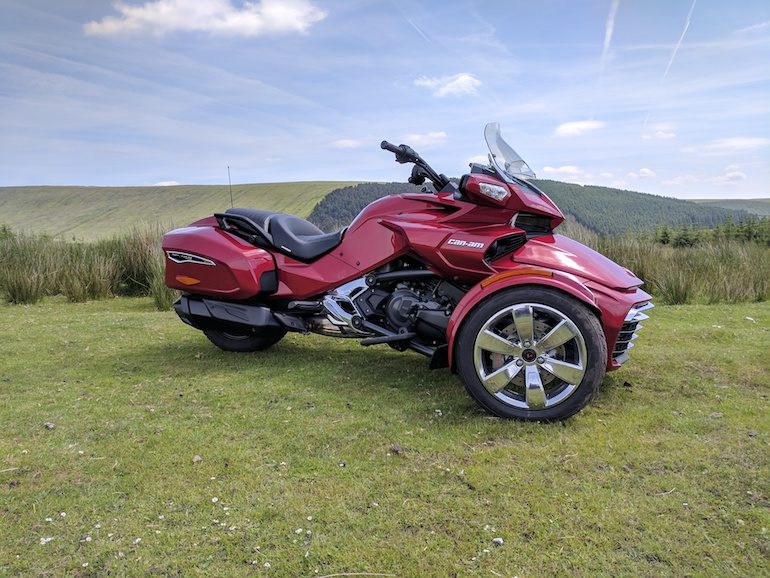
In the City it’s Alright*
Built in Quebec by Bombardier Recreational Products – not to be confused with Bombardier, Inc., which sold off BRP in 2003 – the Spyder F3-T has a distinctly North American feel. This is a vehicle made for big, open roads and crossing states and provinces that don’t allow filtering (ie, lane splitting). As such, urban areas are where the three-wheeler shines the least. It is wide – about 5 feet from port to starboard – and when sitting behind the ‘bars it feels even wider.
At least you can accurately gauge that width, since it’s in front of you. Unlike a trike (and definitely do not call this a trike), the Spyder’s set-up puts its two wheels up front. You can see them in your peripheral vision and accurately determine how much space is needed to get around this or that thing. I prefer things this way; having two wheels behind you puts you at risk of suffering an out-of-sight-out-of-mind lapse of focus. I almost ran a Harley-Davidson Freewheeler into a car once because I had forgotten that the back was so much bigger than the front.
Riding through an urban environment, all that width means you’re more or less confined to the same sort of actions you might make in a car. Forget about filtering, forget about darting in and out of traffic, especially with the Spyder F3-T’s somewhat agricultural semi-automatic transmission. The transmission is controlled via switchgear on the left side of the handlebar. In layout it is similar to Honda’s DCT system, with one small paddle being used to shift up, and another to shift down.
The system will automatically shift down the gears when you slow or come to a stop, but will not go back up without your input. The plus side to this is that it won’t go reaching for a higher gear when you’re mid-corner – something that frustrated me when I recently spent several weeks living with a DCT-equipped Honda NC750X (story on that coming soon). Whether it’s the bike or the operator making gear shifts, however, the transmission is anything but smooth. I tried blipping the throttle, I tried keeping it open; I tried high revs, I tried low revs; no matter what I did gear changes were always jerky, as if being made by a new rider who’s not yet worked out how to finesse the clutch.
In city situations, where one goes up and down the first few gears a lot, this was pretty annoying. But at least I looked cool.
Your opinion may differ as to whether the Spyder F3-T looks cool, but to me it does. That muscular front end is reminiscent of an American muscle car, the Chevrolet Camaro in particular, and it works for me. I was happy to be seen on this thing, often deliberately choosing to ride through areas with heavy foot traffic so as to ensure the maximum number of onlookers. And believe me, when you ride a Spyder people look; this is not a vehicle for someone currently in the Witness Relocation Program. Everyone wants to talk to you about it. At stoplights and even in slowly moving traffic, people were rolling down their windows to ask me questions.
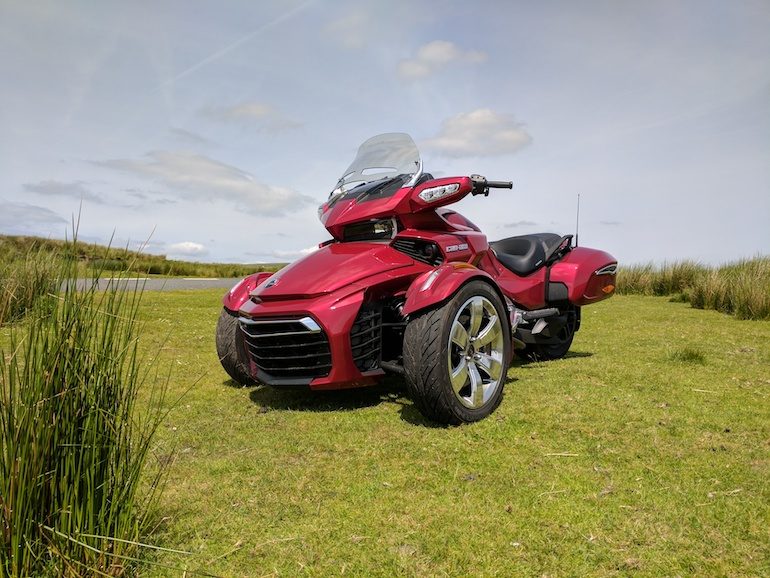
Built for the Open Road
One of the benefits to having two wheels upfront – as opposed to a trike’s two wheels at the rear – is stability. I’m going to run afoul of the hardcore trikers here but it’s always been my feeling that trikes feel unsettled. At fun speeds the handlebars on a trike get wobbly and the mind fills with horror stories about the days of Honda’s three-wheel ATVs. Dudes who ride trikes regularly insist they don’t experience this, so perhaps it’s a sensation you get used to but I prefer the surefooted feel of the Spyder. It feels planted; no wobble even at lose-your-license speeds.
READ MORE: Top 10 Most Frightening Motorcycles | RideApart
With this feeling of solidity, thoughts of dramatic cross-continent adventures come easily. At one point during my three weeks with the Spyder F3-T I very seriously considered riding it to Vladivostok and back (a round trip of 15,200 miles) just for the sake of being able to experience the three-wheeler at its best. OK, when I say “very seriously considered” what I mean is that I checked the price of a Holiday Inn in Belarus, but you get my point. It’s a machine that makes you want to travel.
If you do travel, however, you’ll want to invest in a few Kreiga bags or the like, because the Spyder F3-T’s luggage accommodations are surprisingly miserly. Neither pannier has the height to accommodate a Macbook, nor the depth to swallow much more than a leather jacket. I find this strange considering how wide the front end is; there’s plenty of space in which to put larger, more useful sidecases. In fairness, the panniers’ paucity is somewhat remedied by a nifty trunk in the front, large enough to take on a 5kg bag of charcoal and bag of Jack Daniels wood chips, but really you’re not going to make it much farther than Berlin with just the standard storage space.
The ergonomics of the vehicle suit my 6-foot-1 frame well for long hauls, but the guarantee that it’s not going to tip over meant my 5-foot-8 wife was equally comfortable steering it around. She was able to do that despite not yet having her motorcycle license because in many parts of the world (including the UK) you can ride a Spyder with just a car license. My wife was equally happy on the large, ultra-comfy passenger seat, which – like the rider accommodation – offers a fair bit of room in which to move around. However, she does take issue with placement of the antennae for the Spyder F3-T’s radio. Every time she got on or off the three-wheeler she caught the antennae with her foot.
Cruise control comes standard and works well, managing to keep things within 1 mph of your desired speed, even when going up and down hilly stretches. You can cruise comfortably all day at 80 mph with enough left over to zip past other vehicles, but the closer you get to license-ban territory the more quickly you’ll run out of puff. The Spyder F3-T will do the ton, but you’ll need a good amount of straight to achieve it.
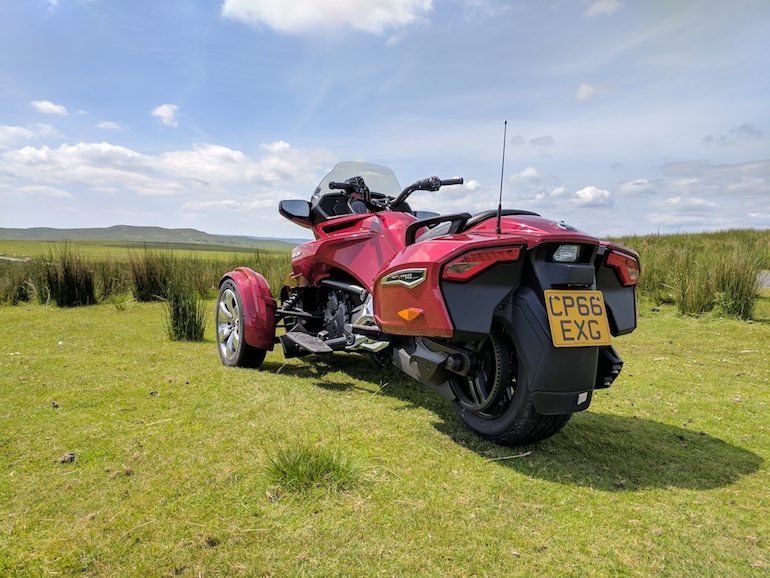
On the Backroads
The thing that really surprised me about riding a Spyder was just how physically engaging the experience can be. This is especially true when husting through corners. Your body moves differently (there’s that word again) than when riding a motorcycle and you feel different forces acting upon you. It’s hardly the sort of passive car-like experience I had imagined.
Flying into a corner I found myself pushing down hard on the floorboards, sometimes almost standing up, to counter the physical forces wanting to propel me outward. You’re not countersteering, of course, and the whole body feels involved. I was amazed to find myself so fully connected. What I’m getting at here is that it was not the “This is what guys too old to ride do” sort of experience I had cynically anticipated. This was actually a lot of fun.
It didn’t take too long for me to start trying to drift the rear end. That enormous car tire on the rear and the presence of the Spyder’s Vehicle Stability System mean it’s not something you’ll ever do unintentionally, but get up enough speed, bang the ‘bars to full lock and SKERRRRK. You will then laugh like a maniac. A little bit of gravel or dirt will help you pull this off more effectively and when you get it just right it will become your most favorite thing. I wonder if Can-Am would be willing to let me borrow a Spyder around the time of next year’s Dirt Quake…
One of the better things about the Spyder experience is that you can have a whole lot of fun at (or pretty close to) legal speeds. Again, I think this speaks to its North American roots. In Canada and Trumpistan the police tend to take speed limits a little more seriously, so having a time-bending speed beast is really just a waste of potential – you never get to use it. You never get to experience the vehicle at its best. With the Spyder, however, you can take a 45mph corner at 45 mph and be having the time of your life.
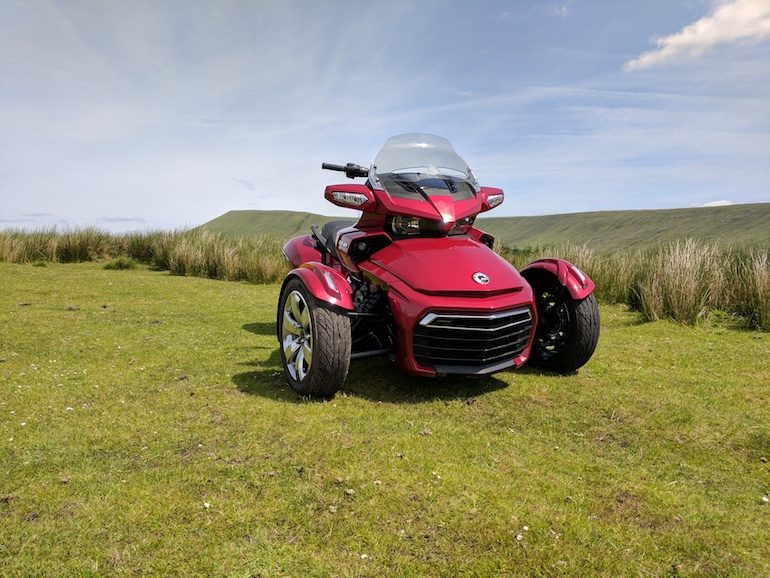
Practicality
Because it is made by a company that also makes snowmobiles and jetskis, and, well, it sorta looks like a snowmobile or a jetski, I’d suspect most people wouldn’t immediately think of the Spyder F3-T as an everyday vehicle. And certainly this three-wheeler lacks some of the main commuting advantages of a motorcycle whilst also lacking the contained-environment advantages of a car. Though, smaller is always better when it comes to parking and the Spyder has a useful reverse gear. Not some über-slow gear that runs off the starter motor but an actual reverse gear that allows you to swiftly back into or out of spots. Related to that, the Spyder weighs roughly half a ton wet, so no one’s going to be picking it up and throwing it into the back of their van.
READ MORE: Ride Review: The Tire-Roasting 2015 Can-Am Spyder F3 | RideApart
I was able to reliably get 200 miles from the vehicle’s 27-liter (7.1 US gallons) tank before seeing the fuel warning light. That’s not fantastic, but it’s equally not awful. Can-Am suggests you can get 35 mpg, so my riding style may have been a little too enthusiastic. Meanwhile the nature of the machine’s design means quite a bit of your body is protected from the elements, and heated grips come standard. Not to mention the fact a third wheel makes inclement weather far less scary; you won’t fall over.
So, the Spyder could actually be quite a practical machine. Certainly it is, as I say, practical for long-distance travelling; and although riding it can be quite engaging through corners, it’s relaxed and easy on the superslab.
What Everyone Else Says
“The F3 can be a sedate, stable touring platform that just plain won’t fall over, or it can be ridden in a sporting manner that results in much fun. We’re not lying.” – Peter Jones, Cycle World
“The Spyder, despite its big engine and 115 horsepower, does not encourage samurai behavior. It’s far more likable as a meandering cruiser, the scenery taken in at posted speed limits.” – Aaron Robinson, Car and Driver
“Three-wheelers like the Spyder… offer a fun, inclusive alternative to riders for whom motorcycles are not an option. The Spyder takes the idea to its zenith with high performance, comfort, convenience, great handling and safety.” – Mark Tuttle, Rider Magazine
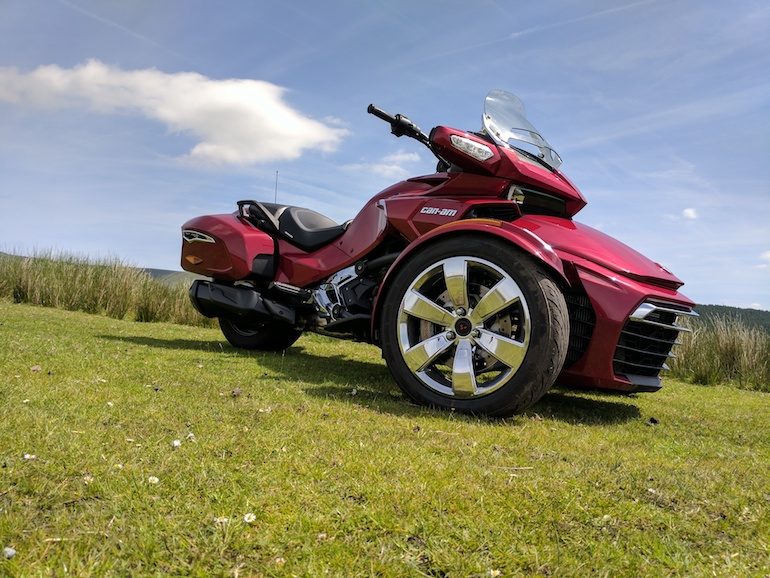
The Little Things
Along with the jerky transmission the thing that irked me most about the Spyder F3-T was the fact its stereo is not loud enough. I think stereos on bikes and three-wheelers are silly, but if you’re going to have them they should be audible above 40 mph. No such luck here; on the motorway I was forced to sing Taylor Swift songs unaccompanied.
Another annoyance is the fact that potholes are effectively unavoidable with a vehicle like this. You can’t straddle them as you might with a car; you can’t ride around them without swinging into another lane. And the switchgear for the turn signal is such that you will struggle to properly cancel the indicator. Pressing in on the single button more often results in your just signalling in the other direction.
The Best Things
I don’t feel I’ve spoken enough on the look of the Spyder F3-T. Aesthetics are a subjective thing, but I really, really loved just sitting and observing this enormous hot-rod-esque beast of a machine.
Speaking again to its North American roots, the Spyder F3-T has the sort of Made Of Heavy Metal robustness that seems to be a trait among other North American machines, eg, bikes from Indian or Harley, or muscle cars from Chevy or Ford. These vehicles always seem to deliberately lack the finesse of European equivalents. They have a kind of thuggishness to them that, as a Texan, I am genetically inclined to favor. True, the transmission is just a little too unrefined, but the growl of the engine and the feel of the machine as it responds to the road offer the sort of visceral experience I enjoy.
Meanwhile, if the exact flavor of motorcycling is the only flavor of joy you accept, you’ll dislike riding a Spyder. But if the reason you like motorcycles is that you enjoy being outside in the open and free – connecting with a machine and feeling like a little kid – it’s pretty likely you’ll enjoy the hell out of this three-wheeler.
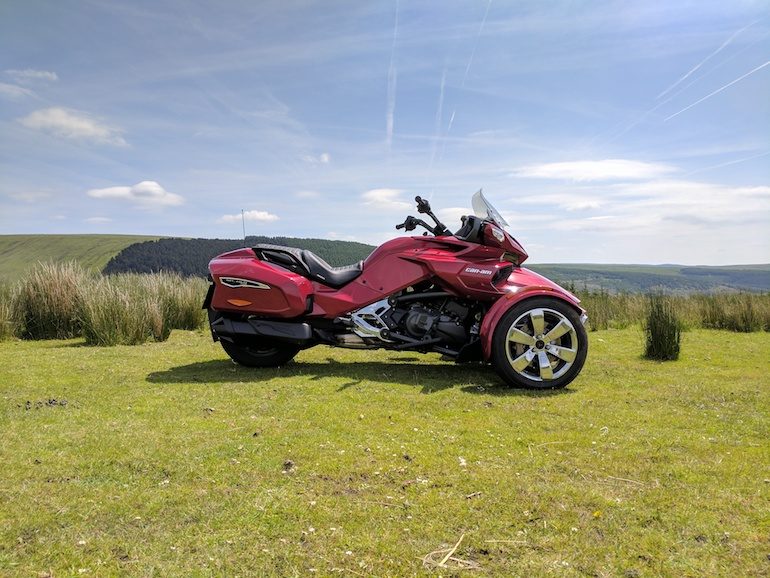
Would I Buy It?
With a starting price of $24,099 in the United States – £21,319 in the United Kingdom – the Spyder F3-T isn’t the sort of thing you’re going to buy on a whim. Less than $2,000 more will get you the Chevy Camaro that I see in the Spyder’s front end (Admittedly, that’s the 2-liter Camaro, so not really a Camaro at all; the Camaro I’d want starts at $64,000). Because I’m able bodied and used to riding motorcycles everywhere and anywhere (I don’t own a car), I’ll admit that if I had that kind of money sitting around I’d probably spend it on a bigger and better motorcycle.
That said, the Spyder’s got a lot going for it. For one thing: it makes two-up touring a hell of a lot more relaxed. There’s no need to stress about the extra weight that a passenger and luggage bring; you’re not going to drop this. My wife is a notoriously fidgety passenger, inclined to suddenly shift at the most inopportune times, but she could have been dancing a jig on the back of this thing and it would not have mattered.
Meanwhile, for folks who aren’t me the Spyder may make a lot of sense. It’s certainly a more accessible experience than motorcycling. I think that may be part of the reason a larger percentage of women make up the customer base than make up the customer base of motorcycles. In the still-too-male-dominated world of motorcycling learning to ride almost always means having to listen to some old dude tell you what to do. Some women (as well as men) don’t really want to be judged by a grandad who talks to you like a 3-year-old because you can’t draw a diagram of a carburetor with your eyes closed.
Additionally, the Spyder’s accessibility is more instantly accessible. It may take years for a person to feel truly comfortable operating a motorcycle, whereas your typical car driver will get the hang of a Spyder in an afternoon. As a reader of RideApart you probably share our fanatical devotion to bikes, but hopefully you can recognize that not everyone sees things the same as you. And that’s an important thing to remember about the whole experience.
Too often motorcyclists look at vehicles like the Spyder F3-T as a kind of alcohol-free beer: a way for a person to get a taste of something when they are unable or unwilling to handle the real thing. That was my impression before throwing a leg over: I saw the three-wheeler as being a tolerable alternative to motorcycling for those who, through injury or age, couldn’t ride a two-wheeler. I realize now that was an ignorant and possibly condescending point of view.
The Can-Am Spyder F3-T isn’t just some alternative for those who can’t or won’t, it’s a different experience. And different is very good.
[“Source-rideapart”]
